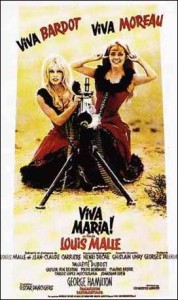related films Viva Maria!

A film co-written and directed by Louis Malle
Released December 18, 1965
Listen to my podcast about Viva Maria
Viva Maria, a Revolutionary buddy movie starring Jeanne Moreau and Brigitte Bardot, both at their most beautiful, was extraordinarily popular among German leftists and radicals. The free-spirited anarchism offered by the film, with equal parts fun, sex, gender-neutrality, bombs, and guns, seemed to be the perfect popular culture realization of the idealized radical, revolutionary lifestyle.
Co-written and directed by Louis Malle, Viva Maria tells the story of two friends, both named Maria, who help lead a Revolution in a Central American republic called San Miguel in 1907.
With almost 50 years since its initial release, it’s sometimes hard to see what the fuss was all about. The film veers wildly between styles; farce, drama, action, slapstick; yet it never seems to gel into coherence. It’s one of those films that is described as “rollicking,” which isn’t always the compliment it is intended to be.
Yet it’s easy to see why young German radicals–particularly women–found it so alluring and fascinating. Above all else it presented an extraordinarily rare pairing: two women who were friends throughout a film where they didn’t fight with each other over a man, succumb to petty jealousies, or stab each other in the back. This dynamic is rare enough to find in films even today, but in 1965 it was positively revolutionary. Prior to the release of the film, Moreau explained to Time Magazine her reason for accepting the role: “Films have never shown the kind of relationship that can exist between two women. Men like to think that women must be constantly jealous of each other, never trusting, never in rapport. That is not true, of course, certainly not today. This film could show that.”
If there was a single defining characteristic that differentiates the West German terrorist groups of the 1970s from almost every other major terrorist group in history, it was the singular equality of women in leadership and participatory roles. How inspiring Viva Maria! must have been to these proto-terrorist women; two women who were friends and colleagues, sexy and funny, leading a revolution in a corrupt South American state. They bed whomever they wanted, shot guns, set off bombs, and invented strip tease in their spare time… what’s not to love?
It’s hard to overstate how much Viva Maria! was an integral part of the generalized mindset of the young, leftist German in the late 1960s. It was as much a part of their DNA as, say, Star Wars would be to the geek crowd of today. You were as likely to see a poster for Viva Maria! on their flats’ walls as you would a Che Guevara poster. Shortly after the film’s release, Rudi Dutchske, the firebrand student leader who would be the victim of an assassination attempt in 1968, formed the “Viva Maria Group,” a working group of the Berlin branch of the SDS student organization. The purpose was to discuss third world revolutions, and what lessons could be learned from them, including the possible need for violence in the growing student movement. Among the participants in the group was Dieter Kunzelmann, who later co-founded Kommune I.
Just as it’s a mistake to think of Gudrun Ensslin and particularly Ulrike Meinhof as some kind of Feminist icons, Viva Maria! is no ode to Feminism. It’s more of a pre-Feminist romp that simply leaves out the overt sexism and stupidity that typically drove films with dominant women characters.
Is it a good film? Not really. Bardot and Moreau seem to be having a great time, and a pre-nuclear tan George Hamilton smolders up the screen. All three look exceptionally beautiful in this well-shot film. But ultimately the movie never seems to make up its mind as to what kind of film it is.
That task was apparently left to the viewer. In the case of young leftist Germans, it proved to be nothing less than an inspirational blueprint for their own burgeoning desires for an exciting revolutionary life.
